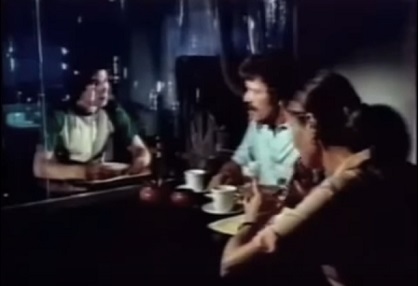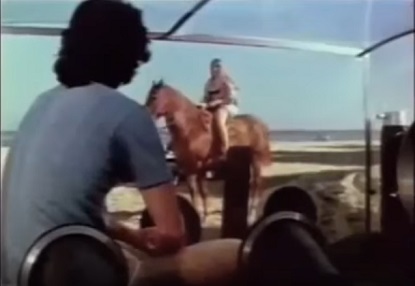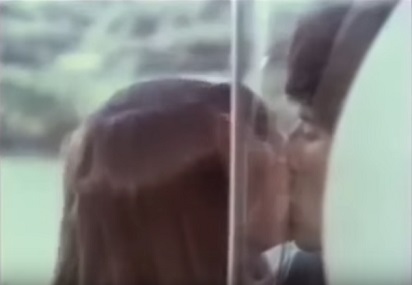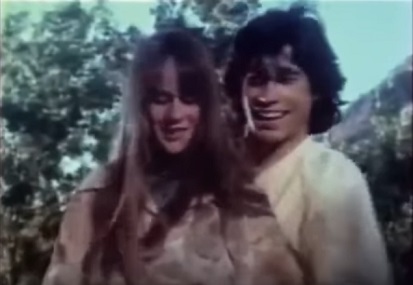I had mentioned in a review a few months back that I miss the days of melodramatic made for TV movies. Lifetime picked up what network television left behind, but there’s a distinct sense of self-awareness to their movies, not quite parody, yet still with a clear message: “We know this is corny, you know this is corny, let’s just accept that and have a good time.” And yet, the seriousness was what made those old movies so much fun! A movie like The Babysitter wouldn’t have been nearly as enjoyable if it came off like it was poking fun at the slasher genre. Cloris Leachman was 100% sincere when she performed the theme song for Someone I Touched, which makes it far more of a good time than stuff with titles like From Straight A’s to XXX or Stalked By My Doctor (let alone its sequel, Stalked By My Doctor: the Return).
Never again will we see anything as earnestly hokey as 1976’s The Boy in the Plastic Bubble. Starring John Travolta in one of his first major dramatic roles, it was loosely based on the true stories of David Vetter and Ted DeVita, both of whom suffered from illnesses that so severely compromised their immune systems that they had to permanently live inside sterile isolation tents. Though Vetter was barely five and DeVita an adolescent when the film was made, Travolta’s character, Tod Lubitch, is seventeen, presumably so much of the plot could focus on an interminable love story.
The film opens with Tod’s birth. His parents (played by Robert Reed and Diana Hyland), who have already lost one child, are understandably devastated to learn that Tod was born “with no immunities whatsoever.” In layman’s terms, if you sneeze near this kid, he could drop dead, and thus he can’t be exposed to germs or viruses of any kind. Though Tod spends the first four years of his life hospitalized, eventually the Lubitchs make the decision to try to care for him at home, upon which Tod becomes a minor celebrity/curiosity.

We jump ahead twelve years, and though Tod’s parents don’t seem to have aged a day, Tod himself has grown into handsome, not terribly convincing as a teenager John Travolta. Virtually their entire house has been turned into a human Habitrail for Tod, who can do everything normal young folks do, except go outside or enjoy the touch of another person. Though Tod’s doctor (Ralph Bellamy) makes vague allusions to treatments that may strengthen his immune system and allow him some freedom beyond his isolation tent, Tod stoically accepts his lonely existence, watching pretty neighbor Gina (Glynis O’Connor) from afar.
Thanks to closed circuit television, Tod is eventually able to participate in classes at the local high school, which allows him to feel closer to Gina, and motivates him to want to become a part of a world that previously represented only danger, illness, and possible death to him. Gina, initially a bit mocking of Tod’s guileless nature (“You shouldn’t tell people you love everything, it makes you sound dumb,” she tells him), gradually warms up to him. Soon, Tod is able to attend school in person, thanks to a special airtight suit. He and Gina are even able to engage in some of the trappings of young love, kissing each other through plastic and taking a kite on the beach.

It’s still not enough for Tod, however, who yearns to be fully free. Faced with the possibility of losing Gina when she’s accepted to art school in New York City, he simply walks out of his isolation tent one day, breathes in fresh air for the first time in his life without any ill effects, and the film ends as he and Gina, finally together without a half-inch of plastic separating them, take a horseback ride into the countryside.
The real life versions of Tod both died within less than a decade after The Boy in the Plastic Bubble was released, and never experienced life outside their own respective bubbles. I did say “loosely based,” alas.
For a “disease of the week” movie (in fact, possibly the most classic example of the genre), there’s surprisingly little disease related drama involved in The Boy in the Plastic Bubble, save for when Tod briefly runs short on oxygen after a pushup contest with a classmate. Despite almost never leaving his house (and being spoken of as though he’s a sort of teen answer to Miss Havisham), he’s smart, reasonably happy, and has little difficulty adjusting to being around his peers. Nobody speaks in absolutes when it comes to his illness (which isn’t even given a name)–something might happen if Tod is exposed to the elements, or it might not, we just don’t know for sure. Every step Tod takes to become part of the world (and ultimately closer to Gina) is successful, and though you expect a big confrontation scene with his parents about wanting too much too fast, it never comes. They barely have any dialogue during the last half hour of the movie, just watching from a distance as Tod and Gina’s romance blossoms.

John Travolta gives a reasonably capable performance, and is at least twice as good looking as every other actor in the movie (including the women). It’s probably a good thing that the dramatic stakes are low, as it’s with the serious scenes that Travolta struggles a bit. In a scene early in the movie when Tod discovers that Gina was paid on a bet to hold hands with him, he throws what can only be described as a kicking and shouting tantrum inside his portable tent, which (presumably unintentionally) makes him look like a weird piece of performance art: Overgrown Manbaby, 1976.
Nevertheless, Tod’s wide eyed joy at discovering the world is charming, and it’s easy to see why Gina would be drawn to him. And yet, call me cynical (okay, you’re cynical), but Tod’s abrupt decision to just step out of his isolation tent like it’s no big deal seems driven primarily by his fear of losing Gina to college halfway across the country. Let’s say that Tod doesn’t die immediately after the movie fades out, what then? Does Gina decide to stay in her hometown with him, now that they’re able to make out and enjoy awkward teenage sex? Or does Tod follow her to New York? Is it fair to impress upon Gina the knowledge that her boyfriend quite literally put his health and even his life at risk just to be with her? How reasonable is it that Gina, in addition to trying to deal with the normal ups and downs of young adulthood, will now be forced to carefully scrutinize every cough, sneeze or groan Tod lets out as a possible sign that his immune system is failing?

